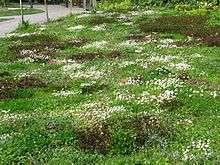Tapestry lawn
A tapestry lawn (also referred to as a grass-free lawn[1]) is a lawn format that has no grass component and is instead formed by using many different mowing tolerant plant species in combination. The overall visual effect of the many species of plant grown together is referred to as a tapestry. The format is based on research carried out at the University of Reading. Developed with temperate humid oceanic climate in mind, it applies ecological principals and horticultural practices to address some of the ecological and environmental issues associated with traditional grass lawns[2][3][4]

Management
The lawn-defining and traditional practice of mowing is the key management tool in tapestry lawns. The need for its application is reduced by up to two thirds compared to traditional mowing regimes [5] because of the absence of grasses (monocotyledons) and the growth patterns of forbs (dicotyledons)[5]. A consequence of this is that greater numbers of both plant and insect species are able to inhabit the lawn.[6]
Mechanisms
In tapestry lawns mowing not only operates to maintain a low lawn-like aspect but it also repeatedly modulates the light environment and intentionally creates physical stress. The relatively taller plant species used gradually take more and more of the light as they grow, creating internal shade within the lawn and stressing the lower growing plants. When mowing is applied it removes the tall growth. This allows light to reach the light starved low growing plants and stresses the tall plants by reducing their size and photosynthetic area. The tall plants stop growing and use reserves of carbohydrates to repair the damage. Once the damage has been repaired, they begin to regrow from a reduced size plant. The low growing plants take advantage of the post-mowing window of opportunity to access light. In this way both low growing prostrate plants and the somewhat taller plants can be grown together.
Plants
Suitable plant species for the tapestry lawn tend to have origins in NW Europe but can include species from other temperate regions:
- Acaena inermis
- Achillea millefolium
- Ajuga reptans
- Bellis perennis
- Chamaemelum nobile
- Glechoma hederacea
- Leptinella dioica
- Lobelia pedunculata
- Lysimachia nummularia
- Pilosella officinarum
- Ranunculus repens
- Trifolium repens
- Veronica chamaedrys
- Viola odorata
The primary component species of tapestry lawns all show the capacity for clonal reproduction i.e. they can spread and reproduce through rhizomes, stolons, adventitious roots and other clonal methods. Other component species include those that are able to successfully set seed in a mown environment e.g. daisies (Bellis perennis). Non-clonal species and those that do not manage to set seed in a mown environment can also be used, although these may require replacement at the end of their natural lifespan.
Some of the plants used have a role in providing simple ground cover (Leptinella sp) and evergreen cover in winter (Ranunculus repens). Some species can be herbaceous and give autumn foliage colour (Argentina anserina); some produce flowers and extend the floral season from spring to autumn (Veronica chamaedrys, Parochetus communis). The use of cultivars brings foliage effects (Ajuga reptans ‘Burgundy Glow’), and allows for lawn gardening – where plants are added and subtracted according to requirements. A wide variety of plant species is used, with a minimum of twelve different species and no upper limit, since environmentally unsuitable species will soon die out.[7] When more species are used there is greater scope for aesthetic choices, extending floral period and resource opportunities for pollinating insects and less chance of any one species becoming dominant in the lawn.
Creation
Unlike traditional grass lawns that use seed mixes tapestry lawns are created by using individual plant species in either pots or trays that are then combined in a mosaic style at planting.
References
- ↑ http://www.grassfreelawns.co.uk/
- ↑ Peel, M.C., B.L. Finlayson, and T.A. McMahon, Updated world map of the Köppen-Geiger climate classification. Hydrol. Earth Syst. Sci., 2007. 11(5): p. 1633-1644.
- ↑ Allen, W., Balmori, D., Haeg, F.,, Edible Estates: Attack on the Front Lawn.2010: Metropolis Books.
- ↑ Borman, F.H., D. Balmori, and T.G. Geballe, Redesigning the American Lawn. A Search for Environmental Harmony. 2nd ed2001, New Haven & London: Yale University Press.
- ↑ Smith, L.S. and M.D.E. Fellowes, The grass-free lawn: management and species choice for optimum ground cover and plant diversity. Urban Forestry & Urban Greening., 2014. 13: p. 433-442
- ↑ Smith, L.S., et al., Adding ecological value to the urban lawnscape. Insect abundance and diversity in grass-free lawns. Biodiversity and Conservation, 2014. 23: p. 1-16.
- ↑ Smith, L.S. and M.D.E. Fellowes The influence of species number on productivity, ground coverage and floral performance in grass-free lawns. Landscape and Ecological Engineering., 2014. DOI: 10.1007/s11355-014-0264-9 DOI: 10.1007/s11355-014-0264-9.